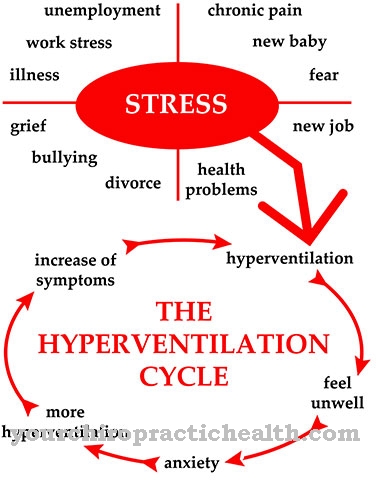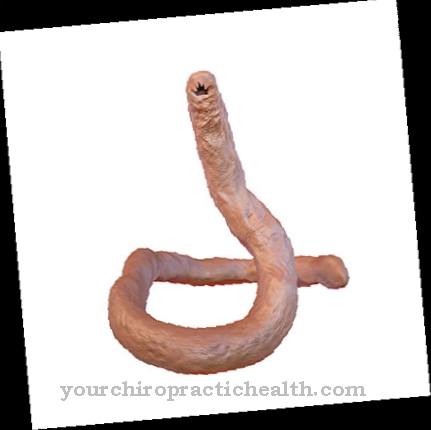A Joint inflammation or. arthritis is an inflammatory disease of the joints. Typical signs are severe pain in the joints, red swellings, and hot and warm inflammations. There are different forms of joint inflammation. The most common form of arthritis is rheumatoid arthritis.
What is arthritis?
.jpg)
The technical term for joint inflammation is arthritis and it comes from the Greek. The syllable "Arth" stands for joint and the ending "itis" stands for inflammation in Greek. It includes joint inflammation with a wide variety of causes. There are infectious and rheumatoid arthritis. Other common joint inflammations are gout and psoriatic arthritis.
However, there are many other causes of joint inflammation as well. Any joint in the human body can be affected. If several joints are inflamed at the same time, one speaks of polyarthritis. If only one joint has monoarthritis. There is sudden, mostly infectious, joint inflammation and prolonged ones. These are then often chronic.
causes
Joint inflammation can have a wide variety of causes. In the case of an infectious joint inflammation, bacteria or viruses have triggered the inflammation. There is a possibility that this could get into the joint through an outside wound. They can also be brought into the joint through the bloodstream from a source of infection in the body.
In an autoimmune disease, the joint is falsely attacked by the body's immune system. This then leads to joint inflammation there. Well-known autoimmune diseases are psoriasis, ulcerative colitis, rheumatism, Crohn's disease and ankylosing spondylitis. If you have a metabolic disease such as gout, the increased uric acid level triggers an attack and causes joint inflammation.
A disease of the cartilage in the affected joint, for example due to wear and tear, can lead to joint inflammation. Arthritis can also have malignant causes. For example, it is possible that a tumor forms in the joint or the joint capsule is attacked by malignant cells (leukemia). This can also lead to joint inflammation.
Symptoms, ailments & signs
Although arthritis can have a variety of causes, there are general symptoms that almost always occur. These symptoms include pain, swelling, redness, and overheating of the joints. Furthermore, there is limited mobility. Sometimes fluid collects in the joint (joint effusion).
Pus formation in the joint (joint empyema) is also possible. However, the specific symptoms depend on the particular cause. When rheumatoid arthritis is present, you typically experience morning stiffness, night and morning joint pain, and swelling in the metacarpophalangeal and metacarpophalangeal joints. In the case of a gout attack, on the other hand, there is severe pain in the big toes, which also heat up, swell thickly and turn red.
Reactive arthritis can develop after a bacterial infection. As with all forms of arthritis, this is characterized by sudden pain and swelling in the joints. Reactive arthritis occurs especially in children after a gastrointestinal or urinary tract infection. If the arthritis is caused by autoimmune reactions, it can be an accompanying disease of severe intestinal inflammation such as Crohn's disease or ulcerative colitis, psoriasis or ankylosing spondylitis.
Arthritis can take an acute as well as a chronic course. Acute arthritis usually heals completely with treatment. Chronic courses can lead to the complete destruction and misalignment of the joints as well as permanent disabilities.
course
The course of a joint inflammation depends on its cause. The success of treatment in acute, infectious joint inflammation is usually very good if treated in good time.
Chronic joint inflammation usually does not heal and gets worse over time.
Persistent and repetitive inflammation in the joints damages the hyaline articular cartilage and ultimately also attacks the bones.
In these cases, after some time, this leads to a functional impairment in the affected joint, due to the joint inflammation. With a longer course, the pain intensity and also the duration of the attack increase.
Complications
With the various forms of joint inflammation, there are complications in many cases, even if these can be delayed or alleviated with appropriate treatment. Despite drug treatment and physiotherapeutic measures, the joint can be so severely damaged after a long period of illness that a surgical joint replacement is necessary.
- Rheumatoid arthritis
In rheumatoid arthritis, joint erosions, i.e. irreversible wear and tear, usually develop in the first two years. About two thirds of the patients suffer from functional impairment within 5 years. Before modern treatment options existed, around 90% of patients had a disability of varying degrees after 20 years. Today, however, there are considerably fewer.
- Psoriatic arthritis
The mortality rate in patients with severe psoriatic arthritis is higher than in the general population. The subjectively perceived quality of life is also impaired by the disease. This form of arthritis manifests itself as pain, swelling and stiffness in the joints, especially of the hands and feet, and is accompanied by the skin symptoms of psoriasis. This results in severe impairments in everyday life and at work.
- Bacterial arthritis
Bacterial arthritis is an acute and life-threatening disease. The rapid spread of the inflammation can cause severe damage to the joint within a very short time, especially in the event of an infection with the pathogen Staphylococcus aureus. If the pathogen penetrates the bloodstream, life-threatening sepsis can occur.
When should you go to the doctor?
In the event of joint problems, a doctor should be consulted as soon as they are not triggered by a brief or one-off overload. If there is pain or restriction of movement, a doctor is required to clarify the symptoms. If the symptoms increase in intensity or if other joints become infected all over the body, a doctor's visit is required.
A doctor should be consulted in the event of increased body temperature, irritability or restlessness. If the usual level of performance drops or if usual everyday activities can no longer be performed, a doctor's visit must be made. It is advisable to consult a doctor in the event of unilateral stress or problems with the muscles, tendons or nerves.
If the inflammation of the joints changes behavior or mood swings, there is cause for concern. The consultation of a doctor is necessary if it comes to an aggressive demeanor or a melancholy mood.
Consult a doctor in the event of sleep disorders, reduced participation in social life, listlessness or apathy. If the symptoms persist for several weeks or if there are further impairments, a doctor is required. If professional obligations can no longer be fulfilled, a doctor's visit must take place. If there are disturbances in concentration or attention, it is advisable to consult a doctor.
Doctors & therapists in your area
Treatment & Therapy
The therapy and treatment of joint inflammation also has to be geared to the causes. The causative disease must always be treated. In the case of acute joint inflammation, the joint is always immobilized, cooled and elevated.
In addition, pain relievers and anti-inflammatory drugs can be given to help the joint inflammation subside. If the joint inflammation is caused by an infection, it should be treated with antibiotics. In the case of rheumatoid arthritis, special rheumatoid drugs can be taken. If the joint inflammation is caused by an autoimmune disease, it is helpful to take so-called immunosuppressants. These suppress the body's own immune system.
Surgery can also remove certain causes of joint inflammation. For chronic inflammation, physiotherapy, physical therapy or occupational therapy are often used. This is to prevent the joints from stiffening.
Exercise in the form of exercise, a balanced diet, and an appropriate body weight can slow the progression of chronic joint inflammation.
Outlook & forecast
The prognosis for a joint inflammation is very individual. However, it is true that an early diagnosis and an early start of treatment significantly improve the prognosis. If treatment for arthritis is started early, its course can be greatly slowed down or even stopped. Newer forms of treatment are very promising here.
If, on the other hand, there is no treatment, the joint inflammation can spread to all joints within an indefinite period of time. This can take weeks or years. In around 70 percent of all those affected, the arthritis gets worse over time, only in around 10 to 30 percent can it be observed that the joint inflammation does not seem to worsen.
Untreated arthritis can lead to incapacity for work and severe pain, while treated arthritis hardly affects the quality of life. In addition, the longer the untreated disease lasts, the greater the risk of damage to the organs. The eyes, lungs or heart can be affected.
Overall, the life expectancy of people with arthritis who are not receiving optimal treatment is reduced by a few years. Overall, it can be said that a halt in the disease is a goal to be achieved in treatment. This can also be achieved with a later diagnosis.
Aftercare
Joint inflammation should be treated with optimal follow-up care. If a person has arthritis, drug therapy is used in most cases. During this therapy, it is specifically coordinated which aftercare the patient needs. It depends on how severe the inflammation is in his joints.
The therapy is often started with the administration of painkillers, which ensure that the inflammation in the joint subsides. Immobilizing the affected joint also helps in healing. The regular follow-up examinations are an important part of the therapy. In bacterial infections, arthritis is treated with antibiotics.
Because if the affected joint is infected with bacteria, the inflammation cannot be fought with simple painkillers. The duration of this antibiotic therapy depends on the extent of the inflammation. If the follow-up examinations are not taken, painful and dangerous long-term consequences can occur.
The joints can become infected, although it is not unlikely that the inflammation can spread to other areas of the body. This is precisely why it is important to always listen to the instructions and advice of the doctor and attend the follow-up examinations in the case of arthritis.
You can do that yourself
In order to improve their own health, the sick can pay attention to a balanced exercise and a healthy lifestyle. Overloading from standing or running for long periods of time as well as one-sided physical posture should be avoided. A poor posture of the body leads to further damage in the long term. Negative effects on the skeletal system or muscles can develop. In addition, all sports that put a lot of stress on the joints should be avoided.
With joint-friendly sports such as swimming or walking, the sick person helps himself and his health. In addition, nutritional supplements help improve the joint cartilage and synovial fluid. With a healthy diet, the sick person prevents obesity.
Too much weight leads to joint problems and worsens the current state of health. A vitamin-rich diet, on the other hand, supplies the organism with vitamins B and E. These have a positive effect on joint problems. The cooling of joints and any swelling that occurs helps to alleviate the symptoms.
Pollutants such as alcohol and drugs are to be avoided in order not to trigger an increase in inflammatory symptoms. The use of relaxation techniques is also helpful and supportive. Autogenic training or yoga promote a mental strength that is useful in dealing with the complaints on a day-to-day basis.


.jpg)


.jpg)







.jpg)

.jpg)
.jpg)











.jpg)